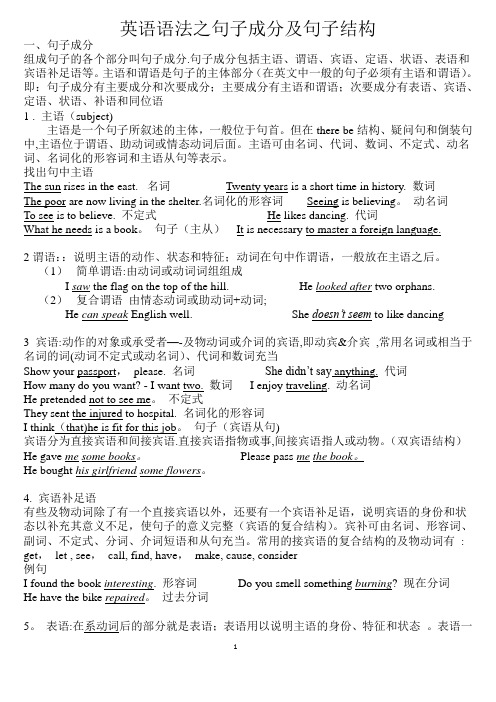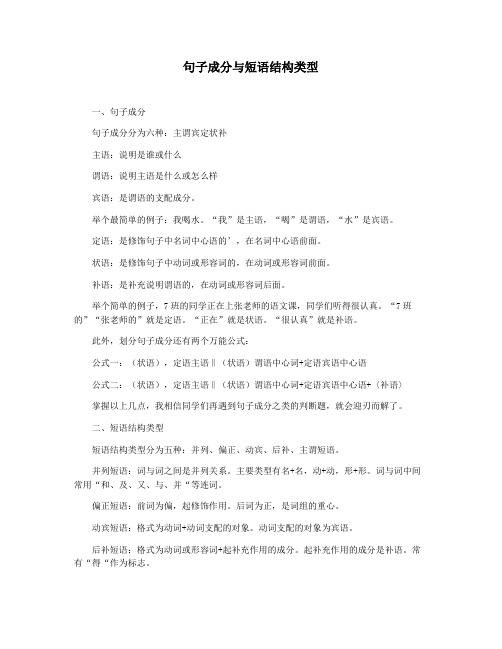句子成分句子类型句子结构
讲义:句子成分及句子结构

英语语法之句子成分及句子结构一、句子成分组成句子的各个部分叫句子成分.句子成分包括主语、谓语、宾语、定语、状语、表语和宾语补足语等。
主语和谓语是句子的主体部分(在英文中一般的句子必须有主语和谓语)。
即:句子成分有主要成分和次要成分;主要成分有主语和谓语;次要成分有表语、宾语、定语、状语、补语和同位语1 . 主语(subject)主语是一个句子所叙述的主体,一般位于句首。
但在there be结构、疑问句和倒装句中,主语位于谓语、助动词或情态动词后面。
主语可由名词、代词、数词、不定式、动名词、名词化的形容词和主语从句等表示。
找出句中主语The sun rises in the east. 名词Twenty years is a short time in history. 数词The poor are now living in the shelter.名词化的形容词Seeing is believing。
动名词To see is to believe. 不定式He likes dancing. 代词What he needs is a book。
句子(主从)It is necessary to master a foreign language.2谓语::说明主语的动作、状态和特征;动词在句中作谓语,一般放在主语之后。
(1)简单谓语:由动词或动词词组组成I saw the flag on the top of the hill. He looked after two orphans.(2)复合谓语由情态动词或助动词+动词;He can speak English well. She doesn’t seem to like dancing3宾语:动作的对象或承受者—-及物动词或介词的宾语,即动宾&介宾,常用名词或相当于名词的词(动词不定式或动名词)、代词和数词充当Show your passport,please. 名词She didn’t say anything. 代词How many do you want? - I want two. 数词I enjoy traveling. 动名词He pretended not to see me。
句子是什么结构类型

句子是什么结构类型文章一:句子结构类型简介句子是由词语构成的,用来表达完整思想的语言单位。
根据句子中所包含的成分和成分之间的关系,我们可以将句子分为简单句、并列句和复合句三种结构类型。
一、简单句简单句是由一个主谓结构构成的句子。
主谓结构是指句子中只包含一个主语和一个谓语的语法形式。
一个简单句可以用来表达一个完整的含义,也可以用来作为其他复杂句子的构成部分。
二、并列句并列句是由两个或更多对等的成分组成的句子。
这些成分可以是主语、谓语、宾语、状语等。
并列句的构成方式是采用连接词来连接两个或多个句子,使它们之间达到一定的逻辑和语义关系。
多数连接词有and、or、but等。
三、复合句复合句是由两个或更多句子联合构成的句子。
由于复合句是由两个或更多句子组成的,因此它必须包含从属连词或关系词等连接符号。
从属连词包括了因为、虽然、当然等;关系词有that、who、whose等。
复合句可以分为主从复合句和并列复合句两种类型。
文章二:句子结构分类分析各种不同结构的句子对于英语写作和口语表达都有着重要的意义。
通过划分句子结构,我们可以更好地了解怎样用恰当的结构表达意思。
下面来看看句子结构分类中的三个知识点。
一、分正和倒装结构正结构是指主语在谓语前,而倒装结构则是指动词在主语前。
英语倒装结构的主要形式有全部倒装和部分倒装。
全部倒装通常使用在疑问句中,而部分倒装则较少使用。
例如:正结构:We can make a cake.(我们可以做一个蛋糕。
)全部倒装:Can we make a cake?(我们可以做一个蛋糕吗?)部分倒装:Only then did we realize our mistake.(只有那时我们才意识到我们的错误。
)通过正倒两种结构对比,语句的表达方式就会发生变化。
二、区分主语和宾语的位置主语是句子中最重要的成分,它通常出现在谓语前。
但是,在某些情况下,主语可以放在句子的其他位置,这通常发生在强调某个句子成分时:强调主语:It was the teacher who taught us the lesson.(是老师教给了我们这个课程。
句子成分、结构、类型

名、代、 副、介词短语 数
名、形、 代、副、 介短
名、形、 代、介短
名、数
doing to do
doing done to do
doing to do
doing done to do
doing done to do
doing done to do
doing
轻松搞定英语句子
1.句子成分 2.句子结构 3.句子类型
doing to do
doing done to do
doing to do
doing done to do
doing done to do
Tom is a pig. He invented a flying machine. The machine looks very smart. In summer, it becomes very hot. The machine carries him in the air outside.
has received
to provide leaving
to
preparation but
equipment
the
largest
create tens of billions of yuan in profit in the aviation Internet
which
名、代、 副、介词短语 数
名、形、 代、副、 介短
名、形、 代、介短
同位
与前词同地位 无标点、逗号、 破折号、or、 such as,as
名、数
doing to do
doing done to do
doing to do
doing done to do
简单句的5种结构及9种句子成分

简单句的5种结构及9种句子成分一、句子的成分(一)、句子各成分的定义句子的组成部分,包括主语、谓语、宾语、定语、状语、表语、补语、同位语和独立成分9种.主语是句子叙述的主体,可由名词、代词、数词、名词化的形容词、不定式、动名词和主语从句等来承担.谓语说明主语所发出的动作或具有的特征和状态。
谓语由动词来承担。
宾语是动作的对象或承受者,常位于及物动词或介词后面。
宾语可由名词、代词、数词、名词化的形容词、不定式、动名词、宾语从句等来担任。
主语和谓语是英语句子的两大成分,除少数句子(如祈使句和感叹句等)外,一句话必须同时具有主语和谓语所表达的意思才能完整.主语是针对谓语而言的,是一句话的主题,谓语用来说明主语的情况,为主语提供信息。
例如:They are working.主语是they(他们),那么他们在做什么呢?看来没有谓语are working 是不行的.在正常情况下,英语的主语和谓语的位置与汉语一致,也就是说主语在前,谓语紧跟其后。
定语用于描述名词,代词,短语或从句的性质,特征范围等情况的词叫做定语,定语可以由名词,形容词和起名词和形容词作用的词,短语担任。
如果定语是单个词,定语放在被修饰词的前面,如果是词组,定语放在被修饰词的后面。
状语说明事情发生的时间,地点,原因,目的,结果方式,条件或伴随情况,程度等情况的词叫状语。
状语一般由副词、介词短语、分词和分词短语、不定式或相当于副词的词或短语来担当。
其位置一般放在句末,但也可放在句首或句中,修饰动词、形容词、副词等。
补语的作用对象是主语和宾语,具有鲜明的定语性描写或限制性功能,在句法上是不可或缺的。
补语是起补充说明作用的成份.最常见的是宾语补足语。
名词、动名词、形容词、副词、不定式、现在分词、过去分词都可以在句子中作宾补.表语是用来说明主语的性质,身份,特征和状态。
表语须和系动词一起构成句子的复合谓语。
表语一般放在系动词之后.表语可以由名词,形容词或起名词和形容词作用的词和短语担任.同位语当两个指同一事物的句子成分放在同等位置时,一个句子成分可被用来说明或解释另一个句子成分,前者就叫做后者的同位语(appositive).这两个句子成分多由名词(代词)担任,同位语通常皆放在其说明的名词(代词)之后。
英语句子成分及英语句子结构讲解

一、英语句子成分和英语句子结构讲解:〔一〕句子成分1.主语〔 subject〕: 句子说明的人或事物。
主语可以由名词、代词、数词、不定式、动名词、分词、主语从句和短语等来担任。
The sun rises in the east〔.名词〕He likes dancing.〔代词〕Twenty years is a short time in history. (数词 )Seeing is believing.〔动名词〕To see is to believe.〔不定式〕What he needs is a book. 〔主语从句〕It is very clear that the elephant is round and tall like a tree.(It 形式主语,主语从句是真正主语〕找出以下句中的主语:Jane is good at playing the piano〔.名词〕She went out in a hurry.〔代词〕Four plus four is eight.〔数词〕To see is to believe〔.不定式〕Smoking is bad for health.〔动名词〕The young should respect the old.〔名词化的形容词〕What he has said is true. 〔句子〕谓语〔 predicate〕: 说明主语的动作、状态和特征。
简单谓语 :由动词或动词词组组成I saw the flag on the top of the hill?He looked after two orphans.复合谓语:由情态动词或助动词+动词 ;He can speak English well.She doesn ’ t seem to like dancing.找出以下句中的谓语〔注:只有动词才可作谓语。
〕:1.We love China.2.We have finished reading this book.3.He can speak English.4.She seems tired.3.表语〔 predicative〕: 系动词之后的成分,表示主语的性质、状态和特征。
句子成分与短语结构类型

句子成分与短语结构类型一、句子成分句子成分分为六种:主谓宾定状补主语:说明是谁或什么谓语:说明主语是什么或怎么样宾语:是谓语的支配成分。
举个最简单的例子:我喝水。
“我”是主语,“喝”是谓语,“水”是宾语。
定语:是修饰句子中名词中心语的’,在名词中心语前面。
状语:是修饰句子中动词或形容词的,在动词或形容词前面。
补语:是补充说明谓语的,在动词或形容词后面。
举个简单的例子,7班的同学正在上张老师的语文课,同学们听得很认真。
“7班的”“张老师的”就是定语。
“正在”就是状语。
“很认真”就是补语。
此外,划分句子成分还有两个万能公式:公式一:(状语),定语主语‖(状语)谓语中心词+定语宾语中心语公式二:(状语),定语主语‖(状语)谓语中心词+定语宾语中心语+〈补语〉掌握以上几点,我相信同学们再遇到句子成分之类的判断题,就会迎刃而解了。
二、短语结构类型短语结构类型分为五种:并列、偏正、动宾、后补、主谓短语。
并列短语:词与词之间是并列关系。
主要类型有名+名,动+动,形+形。
词与词中间常用“和、及、又、与、并“等连词。
偏正短语:前词为偏,起修饰作用。
后词为正,是词组的重心。
动宾短语:格式为动词+动词支配的对象。
动词支配的对象为宾语。
后补短语:格式为动词或形容词+起补充作用的成分。
起补充作用的成分是补语。
常有“得“作为标志。
主谓短语:格式为主语+谓语。
即“谁或什么”+“是什么或怎么了”。
掌握以上几点,判断短语结构类型也不是什么太困难的事。
感谢您的阅读,祝您生活愉快。
句子结构,句子成分,五种基本句型

英语句子成分分析句子是按照一定的语法规律组成的,表达一个完整的意义。
一个句子一般由两部分构成,即主语部分和谓语部分,这两部分也叫做句子的主要成分。
句子的次要成分包括宾语,定语,状语,表语等。
句子成分是句子中起一定功用的组成部分.1)主语:是一句的主体,是全句述说的对象,常用名词,数词或代词担任,一般放于句首.如:Students study. (学生学习)We are friends.(我们是朋友)这两句话中单词students是个名词,we是代词,它们在句中做主语。
2)谓语:是对主语加以陈述,表示主语的行为或状态,常用动词或者动词词组担任,放在主语的后面。
如:Students study. (学生学习.)We are friends。
(我们是朋友)这两句话中单词study和are都是动词,study叫做实意动词,are叫做be动词,它们在句中作谓语。
3)宾语:表示行为的对象,常由名词或者代词担任。
放在及物动词或者介词之后。
如:They are teachers。
( 他们是老师。
)I play with him. (我和他一起玩。
)这两句话中单词teachers是名词,单词him是带词,它们在句中作宾语。
4)定语:是用来说明或者限制名词的成分,常用形容词或者相当于形容词的短语或从句担任。
形容词放在名词之前,相当于形容词的短语或从句放在名词的后面。
如:This is a red sun。
(这是个红太阳。
)He is a tall boy。
(他是个高个子男孩。
)这两句话中单词red和 tall都是形容词,它们作定语。
5)状语是用来说明动词,形容词,副词或整个句子的成分.常由副词担任.修饰动词时可以放在动词之前,也可以放在动词之后;修饰形容词或副词时放在它们之前。
如:The students study hard。
(这些学生学习努力。
)I often write to him. (我常给他写信.)The bag is too heavy。
1.句子成分和句子类型

介宾
定语 (Attributive):
• 定语的作用
–用于修饰、限定名词或代词。
• 定语一般由???充当。 形容词 • 定语还可以由名词充当,表用途。
– a pencil box –a beautiful girl 定语
定语 (Attributive):
• 定语也可以由从句或非谓语动词充当。
– Those who want to learn English well should study harder than others. – an interesting book – a meeting to attend – The man over there – The books on the shelf
• 主语还可以由从句或非谓语动词充当。
– Twelve divided by four is three.(数词)
谓语 (Predicate)
• 谓语 表示一个动作、行为,是由
动词充当的。
–I teach you English. 谓语
• 一个句子能不能没有谓语? 不能
宾语 (Object):
• 宾语的分类:
以接复合宾语结构。 • SVOC句型
– I saw him rushing out of the room. OC可以看作复合宾语!
基本句型七
• 这个基本句型的特点是谓语动词可
以接双宾语。 • SVoO句型
– I gave him the book. – I gave the book to him. 辨清直接和间 接宾语!!!
• 定语也可以由副词(词组)或介词(词组)
充当。
状语(Adverbial)
• 状语是用于修饰副词、形容词或动词 •
- 1、下载文档前请自行甄别文档内容的完整性,平台不提供额外的编辑、内容补充、找答案等附加服务。
- 2、"仅部分预览"的文档,不可在线预览部分如存在完整性等问题,可反馈申请退款(可完整预览的文档不适用该条件!)。
- 3、如文档侵犯您的权益,请联系客服反馈,我们会尽快为您处理(人工客服工作时间:9:00-18:30)。
语法专题讲解:句子成分句子成分:组成句子的各个部分叫句子成分。
其中包括:主要成分:主语谓语次要成分:表语宾语宾语补足语主语补足语定语状语同位语㈠主语(sub):句子所陈述的主体。
一般位于句首。
但在there be结构、疑问句(当主语不疑问词时)和倒装句中,主语位于谓语、助动词或情态动词后面。
读下面的句子标出主语并总结能够做主语的词。
1.Honesty is the best quality.2.Nobody can help you.3.Four and five makes nine.4.The sick and the old need our help.5.The wounded should be sent to hospital.6.To become a nurse is my wish.7.Running is good for health. 8.Between six and seven in the morning is the best time.9.When we are going to have an English test has not been decided.10.It is necessary to master a foreign language. 11.There is a teacher and 3students.总结:㈡谓语(v.):表示主语的动作,行为或所处的状态。
(谓语有人称和数的变化)动词及动词短语常在句中作谓语,一般放在主语之后。
观察下面的句子总结谓语动词的构成。
1. He practices running every morning. / The plane takes off at 8 o’clock.2. You may keep the book for two weeks. / He has caught a bad cold.3. Our school becomes more beautiful.总结谓语动词的构成。
1、简单谓语:2、复合谓语:㈢表语(pred.):系动词后用来说明主语的特征,类属,状态或身份等。
系动词的类别:状态系动词:be (is am are was were) seem smell sound taste feel touch stay(保持) remain (依然) look (看上去) appear (显得) keep(保持)continue (继续) stand (以某种方式矗立着)结果(转变)系动词:become grow(长得) come(成为) prove(证明) get (变得)turn (变得) fall (变为) go (变得)观察下面的句子总结哪些词可以做表语:1.It becomes a major problem.2. I am not myself today.3.He was the first to leave.4.The lights are on.5.Wasting time is killing yourself.6.The book is interesting.7.The leaves grow yellow. 8.I am much worried about her health.9.My wish is to become a nurse. 10.I am at work now.11.This is where we disagree.总结:㈣宾语(obj.):表示动作的对象或承爱者,一般位于及物动词和介词后面。
观察下面的句子总结哪些词可以作宾语:1. They went to see an exhibition yesterday.2. The heavy rain prevented me from coming to school on time.3. How many dictionaries do you have? I have five.4. They helped the old with their housework yesterday.5. He pretended not to see me.6. I enjoy listening to popular music.7. I think(that)he is fit for his office. 8. I can’t decide when to start the job.总结:宾语的种类:双宾语:直接宾语间接宾语同源宾语:laugh a…laugh dream a … dream blow a…blow smile a … smile sing a … song live a… life宾语补足语(obj.-c) : 英语中有些及物动词(包括介词with),除有一个直接宾语以外,还要有一个宾语补语,才能使句子的意义完整。
带有宾语补足语的一般句型为:及物动词+宾语+宾补(宾语+宾补也叫复合宾语)观察下面的句子总结那些词可以做宾补:1.She used to sleep with the windows open.2. We made him our monitor.3.He made the class over.4. The parents let their children in their bedroom.5.I get him to do this job by himself.6.I found him wondering along the street.7.I got my car repaired. 8.I don’t know when the meeting will be held.总结:㈤定语(attributive):修饰名词或代词的词、短语或从句称为定语。
定语可由以下等成分表示:观察句子总结能做定语的词:1.Guilin is a beautiful city.2.China is a developing country; America is a developed country.3.There are thirty women teachers in our school.4.His rapid progress in English made us surprised.5. Our monitor is always the first to enter the classroom.6. The teaching plan for next term has been worked out.7. He is reading an article about how to learn English.8.The boy who is standing there is my brother.总结:定语的种类:前置定语后置定语多个形容词作定语的顺序:㈥状语(adv.): 修饰动词、形容词、副词或整个句子,说明动作或状态特征的句子成分。
观察下面的句子总结做状语的词:1.Light travels most quickly.2. He has lived in the city for ten years.3. He is proud to have passed the national college entrance examination.4. He is in the room making a model plane.5.Wait a minute.6. Once you begin, you must continue.总结:观察下面的句子总结状语的种类:1. How about meeting again at six?st night she didn’t go to the dance party because of the rain.3. I shall go there if it doesn’t rain.4. Mr. Smith lives on the third floor.5. She put the eggs into the basket with great care.6. She came in with a dictionary in her hand.7. In order to catch up with the others, I must work harder.8. He was so tired that he fell asleep immediately. 9. She works very hard though she is old.10. I am taller than he is.总结:㈦同位语:是在名词或代词之后的并列名词或代词或名词短语对前者加以说明的成分,在语法上与前者处于同等地位。
观察下面的句子总结做同位语的词:1.We students should study hard.2. We each will have a chance to travel by air.3. Are you three ready?4. The news that we will have a holiday tomorrow is true.总结:㈧独立成分:有时句子中会有一些与句子没有语法联系的成分,称为句子独立成分感叹词:oh, hello, aha, ah, there!(得了得了)come on!hi 等。
肯定词yes 否定词no 称呼语:mum, dad,Mary ,John 。
插入语:一些句中插入的 I think , I believe, Believe it or not 等。
情态词,表示说话人的语气(多作为修饰全句的状语):perhaps也许,maybe大概,actually实际上,certainly当然,等。
